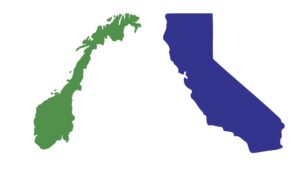
On April 16, 2024, California Gov. Gavin Newsom hosted Norwegian Minister of Trade Jan Christian Vestre in signing a new Memorandum of Understanding (MoU) to advance climate collaboration between the two governments. The MoU comes as California seeks to boost cooperation between like-minded partners in the international arena to stay on track with its 2022 commitment to achieve net-zero carbon emissions by 2045. As Norway seeks to achieve the same goal by 2050 based on a 2019 commitment by the Norwegian parliament, the two governments have signed this MoU to more closely synchronize efforts and partner to achieve their aligned goals in seven different areas.
Even as the Biden Administration has implemented its self-proclaimed “most ambitious climate agenda in history,” California remains a clear leader in addressing climate change amongst international partners. While individual states or provinces acting on their own climate ambitions may seem out of place, California must continue to set the agenda for the rest of the United States (U.S.) as the nation’s hub for innovation and climate action.
While the new MoU signed a few weeks ago is the first of its kind between California and Norway, it comes amidst a recent uptick in Gov. Newsom’s outreach efforts toward international partners to increase climate cooperation. In 2023, Newsom signed seven MoUs with China’s National Development and Reform Commission, the Guangdong, Jiangsu and Hainan provinces, the cities of Beijing and Shanghai and Australia. To highlight the Governor’s trip to China, California and China signed a Joint-Declaration to enhance local-level climate cooperation, which signaled a major foreign policy achievement for Newsom. While the declaration and Newsom’s visit to China in 2023 came amidst a background of souring US-China relations, the subnational efforts by Newsom demonstrated President Xi Jinping’s ability to cooperate on overlapping issues.
Conversely, the U.S. and Norway are already close partners because both are North Atlantic Treaty Organization (NATO) members and have partnered together on many bilateral climate initiatives, such as the Green Shipping Challenge. However, it is fair to question how California might play a role in the U.S. relationship with Norway and why this MoU between California and Norway was necessary. Of the seven key areas of cooperation outlined in the MoU, four objectives include language on decarbonization and the promotion of clean energy. This is no surprise, considering that the Governor’s 2022 Climate Action plan calls for a 48% drop in carbon emissions by 2030 compared to 1990.
As some have dubbed Newsom’s ambitious plan, such as the California Air Resources Board (CARB), which described it as the “most ambitious set of climate goals of any jurisdiction in the world,” the state has faced some obstacles. While Gov. Newsom’s website touts that in 2014, California reached its climate goals six years ahead of schedule, the current plan to achieve net zero by 2045 has largely stalled. Due to difficulties in transitioning existing facilities to meet climate standards and the inability to increase the reduction of yearly carbon emissions, California’s action is faltering. But this is where Norway comes in.
Even though California dwarfs Norway’s economy by a margin of almost three trillion dollars, Norway has achieved some of California’s ambitions, such as accelerating the sale of Electric Vehicles (EVs). Of cars sold last year in Norway, 80% were EVs, whereas in California, that figure remained at 25% despite being the leading figure among U.S. states. In signing this MoU to facilitate the “multi-faceted exchange of knowledge, experience, data and best practices,” California hopes to utilize Norwegian expertise in climate technology like data center decarbonization technology and infrastructure adaptation solutions to offset challenges. Norway boasts one of the world’s most robust climate technology sectors, with 50% of its foreign direct investment in 2023 flowing to that sector.
As each year brings with it a new set of obstacles, such as record-breaking heatwaves, wildfires and flooding, California is looking to the international stage to help build climate resilience within the economy. By signing this MoU with Norway, California continues to demonstrate its commitment to enhance its climate tech sector and boost its ability to fulfill its commitments. By showing the world that a robust economy can be green, other international partners and even states within the U.S. might use California as an example for their own climate ambitions.







